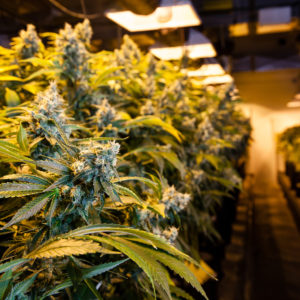In 2016, marijuana legalization and decriminalization efforts won big at the ballot box. It was merely the latest signal that popular opinion is becoming more accepting of cannabis use, both recreational and medical. That is a boon for the industry, which is preparing for sales of both plants and cultivation supplies to surge in the coming years. With marijuana cultivation poised to take off, some are starting to worry about the environmental effects, and specifically the carbon footprint, of marijuana cultivation, suggesting that state governments may need to step in to regulate.
“Whether cultivated indoors or outdoors, it seems undeniable that the marijuana industry has quantifiable negative impacts on the environment and the climate,” writes Gina S. Warren in the Columbia Journal of Environmental Law. Or, as she puts it elsewhere in the article, “the weed is legal but the herb ain’t green.”
The trouble is the carbon footprint. Indoor growing allows for between five and six crops per year, compared to two when growing outdoors. This gain comes at a high energy cost, however. Growing marijuana indoors requires a careful balance of humidity, temperature, and light. In practice, this means that many indoor grow facilities are equipped with 1,000 watt lamps, along with air conditioning and fans to mitigate the heat from the lights and to better disperse moisture in the air.
All of that takes a lot of power. One oft-cited study by New Frontier estimates that marijuana cultivation uses 1 percent of American electricity consumption and another report by a company focusing on clean energy research finds that indoor grow labs have electricity use on par with data centers, or between 50 and 200 times more than the average office complex. It is enough to make environmentalists wring their hands over the carbon footprint of the average joint.
Marijuana has even more of a climate impact in certain states. In Colorado, for example, marijuana cultivation counted for about 0.4 percent of the state’s energy use in 2014. In the Denver area, city officials stated that marijuana cultivation accounted for 2.2 percent of electricity use over the same period. This is tricky, since Colorado continues to generate about 60 percent of its power using coal.
In her paper, Warren explored “regulating pot to save the polar bear.” Marijuana cultivation not only takes a lot of electricity–the crop’s illegal status means that much of that power comes from diesel generators.
“Climate and energy externalities of indoor production, however, cannot be mitigated by simply plugging into the grid,” she writes. “Given the high climate risks, the only responsible option is to require highly energy-intensive industries, such as the indoor marijuana industry, to power their operations with carbon-free electricity.”
The energy use numbers are high enough to cause environmentalists to worry, even though cannabis has not been legalized nationally. Even as far back as 2008, marijuana production through indoor grows was using about $6 billion of energy each year. Meanwhile, the entire pharmaceuticals sector of the economy used about $1 billion.
“Current indoor Cannabis production and distribution practices result in prodigious energy use, costs, and unchecked greenhouse-gas pollution…. There is little, if any, indication that public policymakers have incorporated energy and environmental considerations into their deliberations on Cannabis production and use,” writes Evan Mills in the journal Energy Policy.
Boulder, Colo., for example, requires growers to offset 100 percent of their electricity use with on-site renewables, purchases of renewable energy or carbon offsets, or participation in a community solar garden. The city of Arcata, Calif., assesses a 45 percent tax on residences using more than 600 percent of a baseline of energy. The measure was intended to help the city get on track with its emissions goals, but cracking down on growers was a consideration as well.
So far, the cannabis industry has not taken many major steps to minimize its carbon footprint. As a result, there is already a push for state lawmakers to step in to dictate how it should be grown. Facing the carbon footprint of cannabis cultivation, some supporters are already suggesting that state regulators step in to legislate the use of energy-efficient LED lights in indoor grow facilities. They are hoping that the more that state regulators legislate the details of grow operations, the more energy efficient and green the industry will become.
“While some marijuana businesses are looking to manage energy to cut costs or reduce carbon, the impetus so far is coming from external players, like utilities and local governments,” writes Kelly Crandall in a research paper suggesting methods of taming the soaring energy costs of marijuana cultivation.
At this point, jurisdictions are adopting their regulations on marijuana cultivation on a piecemeal basis. On Tuesday, Denver released a draft best practices guide for marijuana cultivation that highlighted its energy use and carbon footprint, admitting that it might be difficult to balance widespread grow operations with the city’s green goals. While the guide states that, “Denver does not have regulations that place special conditions on energy use for cannabis businesses,” it left the door open for future regulations.
It’s all a question about which sort of green the city wants to support. Marijuana is barely legal, but already it seems that weed is not green enough. Will environmentally conscious tokers soon need to consider their carbon footprint before reaching for a joint?

